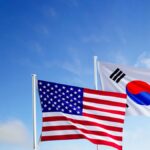Table of Contents
Published: March 24, 2025 | By WorldAffair.org
In 2025, China’s role in the global economy and technology landscape is being reshaped by its strategic pivot towards self-reliance, growing technological competition, and navigating complex trade relationships with the United States, the European Union, and emerging markets. These shifts are not only defining China’s future but are also influencing global economic structures, supply chains, and technological advancements.
China’s technological ambition, particularly in semiconductors, artificial intelligence (AI), and 5G networks, is now at the forefront of international competition. At the same time, trade wars and economic protectionism are further complicating its position in global markets. In this blog, we will explore how China is navigating the global technology race, its ongoing trade relationships, and the implications for the world economy in 2025.

🚀 China’s Technological Ambitions: The Drive for Self-Reliance
In 2025, China is focused on consolidating its position as a technological powerhouse. For years, the country has been heavily reliant on foreign imports for high-tech components, particularly semiconductors. However, in the face of growing tensions with the United States and its allies, China has accelerated efforts to develop its own advanced technologies, including AI, quantum computing, and 5G telecommunications.
Semiconductor Development: A Matter of National Security
China’s semiconductor industry is a key area of focus. While the country remains the world’s largest importer of semiconductors, China has launched ambitious initiatives aimed at reducing its dependency on foreign chips. The Made in China 2025 policy, introduced several years ago, emphasized the importance of technological self-sufficiency, and now, this goal is being pursued more aggressively.
- Domestic Production Push: China’s largest semiconductor companies, like SMIC (Semiconductor Manufacturing International Corporation), are working to ramp up domestic production. Despite facing severe U.S. sanctions that limit access to advanced equipment and technology, China continues to invest heavily in semiconductor research and development.
- Challenges Ahead: Although there have been notable advancements, China still lags behind the U.S. and Taiwan in producing the most advanced semiconductor chips. The key challenge remains acquiring the technology required to produce 7nm and 5nm chips, which are essential for AI, high-performance computing, and advanced consumer electronics.
In 2025, China’s drive for semiconductor independence is one of the central pillars of its technological strategy. Achieving self-sufficiency in chip production would allow China to protect its tech industry from U.S.-led restrictions and sanctions, but the road to achieving this goal is still uncertain.

📱 5G and Artificial Intelligence: Technological Competitiveness
In addition to semiconductors, China is aggressively pushing to dominate the 5G network and artificial intelligence (AI) sectors. These two technologies are seen as critical enablers of future economic growth and geopolitical power.
China’s 5G Networks: A Global Race
China’s Huawei Technologies has emerged as a leader in the global 5G race, offering cutting-edge telecommunications infrastructure to many countries. The 5G rollout is critical for China’s domestic economy, as it promises to support the next generation of smart cities, autonomous vehicles, and industrial automation.
- Global Competition: The U.S. has attempted to block Huawei’s 5G technology in several countries, citing concerns over national security and data privacy. As a result, many Western nations have turned to alternative 5G providers, such as Ericsson and Nokia. Despite these challenges, China is making substantial progress in expanding its 5G infrastructure within its borders and has also succeeded in positioning Huawei as a leading provider in parts of Asia, Africa, and Europe.
Artificial Intelligence (AI) Leadership
China aims to become the world leader in AI by 2030, and its progress is evident. The country’s AI industry has witnessed explosive growth, with applications spanning from facial recognition to automated vehicles. In 2025, China’s AI capabilities are directly linked to its ability to gain economic and political leverage globally.
- AI Innovation: China has several AI giants, such as Baidu, Alibaba, and Tencent, that are investing heavily in AI research and applications. Moreover, the Chinese government has rolled out policies to support AI development, including massive funding for AI start-ups and research institutions.
- International Concerns: The rapid expansion of China’s AI capabilities, particularly in surveillance and data collection, has raised concerns among Western governments regarding privacy and human rights. China’s use of AI to enhance its social credit system and monitor its citizens has led to criticisms of authoritarianism, but its AI industry continues to grow, with international partnerships increasing.
China’s leadership in both 5G and AI is an integral part of its broader goal to lead the technological revolution of the 21st century. However, these advancements come with geopolitical tensions, as rival powers seek to secure their technological future.

🌐 China’s Trade Relationships in 2025: Navigating Economic Protectionism
China’s trade relationships in 2025 remain complex and marked by the ongoing tensions between economic protectionism and the pursuit of global market access. The rise of economic nationalism in the U.S. and other developed economies has reshaped global trade flows, and China must navigate this new reality.
Trade War with the U.S.: Tariffs and Restrictions
Since the U.S. initiated a trade war against China under the Trump administration, tariffs and sanctions have significantly disrupted the flow of goods and services between the two largest economies. While there have been efforts to ease tensions, including the Phase One trade deal signed in early 2020, the relationship remains fraught with challenges.
- Tariff Impact: The imposition of tariffs on Chinese goods by the U.S. has created ripple effects throughout the global economy. In 2025, these tariffs remain a burden on Chinese exporters, particularly in high-tech sectors such as electronics and machinery.
- Technological Sanctions: The U.S. has continued to restrict China’s access to critical technology, including semiconductor manufacturing equipment and advanced AI research tools. This has impeded China’s ability to compete with U.S. tech giants, creating a technological gap that the Chinese government is striving to close.
Despite these challenges, China has also worked to expand its trade relationships with other global players, including the European Union, India, and Africa.
New Trade Deals and Partnerships
In 2025, China has successfully signed several new trade agreements, including regional initiatives like the Regional Comprehensive Economic Partnership (RCEP), which includes major Asian economies and excludes the U.S. The agreement is seen as a counterbalance to Western economic dominance and serves China’s strategic interests by expanding access to growing markets in Asia.
- Belt and Road Initiative (BRI): China’s flagship foreign policy initiative, the Belt and Road Initiative, continues to strengthen its influence across Asia, Africa, and Europe. In 2025, the BRI focuses on infrastructure development, including ports, railways, and energy projects, to bolster trade routes and create dependencies among partner nations.
As China moves towards diversifying its trade relationships, it also faces the challenge of balancing its economic interests with rising protectionism in the West.

🔮 The Future of China’s Global Role: Opportunities and Challenges
China’s global role in 2025 presents both immense opportunities and substantial challenges. The country’s technological advancements and economic strategies are positioning it to be a dominant force on the world stage. However, the path to achieving this dominance is fraught with geopolitical tensions, economic rivalries, and domestic issues.
Opportunities:
- Technological Leadership: As China advances in 5G, AI, and semiconductor manufacturing, it has the opportunity to shape the future of global technology. If successful, China could dominate key tech markets and secure its position as the world leader in technological innovation.
- Trade Diversification: With the diversification of its trade partners through initiatives like RCEP, China can reduce its reliance on Western markets, mitigating the risks posed by U.S.-led economic sanctions.
Challenges:
- Geopolitical Tensions: China’s assertive foreign policy, particularly in the South China Sea and its dealings with Taiwan, continues to stir geopolitical tensions, especially with the U.S., Japan, and ASEAN countries.
- Domestic Instability: China’s rapidly aging population and ongoing economic slowdown present serious risks to domestic stability. Addressing these challenges will be crucial for maintaining economic growth and social harmony.

✍️ Conclusion
As we progress through 2025, China’s role in the global economic and technological spheres will continue to evolve. While the country is striving for greater self-reliance in technology, its complex trade relationships and growing geopolitical influence will shape not only China’s future but also the broader global order. How China manages these challenges will determine its position on the world stage in the years to come, with lasting implications for international relations and economic stability.
Author Profile
- Syed Tahir Abbas is a Master's student at Southwest University, Chongqing, specializing in international relations and sustainable development. His research focuses on U.S.-China diplomacy, global geopolitics, and the role of education in shaping international policies. Syed has contributed to academic discussions on political dynamics, economic growth, and sustainable energy, aiming to offer fresh insights into global affairs.
Latest entries
 Japanese PoliticsSeptember 6, 2025Prince Hisahito’s Coming-of-Age and Japan’s Male-Only Succession Dilemma
Japanese PoliticsSeptember 6, 2025Prince Hisahito’s Coming-of-Age and Japan’s Male-Only Succession Dilemma GeopoliticsAugust 23, 2025Previewing the White House Visit of South Korean President Lee Jae Myung
GeopoliticsAugust 23, 2025Previewing the White House Visit of South Korean President Lee Jae Myung Middle East ConflictJuly 22, 2025Israel’s Deadly Attacks on Gaza: A Dire Humanitarian Crisis and International Calls for a Truce
Middle East ConflictJuly 22, 2025Israel’s Deadly Attacks on Gaza: A Dire Humanitarian Crisis and International Calls for a Truce Middle East & North AfricaJuly 20, 2025Israel Targets Damascus Amid Rising Tensions in Syria
Middle East & North AfricaJuly 20, 2025Israel Targets Damascus Amid Rising Tensions in Syria


